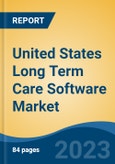Speak directly to the analyst to clarify any post sales queries you may have.
10% Free customizationThis report comes with 10% free customization, enabling you to add data that meets your specific business needs.
Key Market Drivers
Aging Population
The United States is undergoing a profound demographic transformation, with its aging population emerging as a major driver of growth in various sectors, including healthcare. As the baby boomer generation continues to age, the demand for long-term care services is skyrocketing. In response to this demographic shift, the Long-Term Care (LTC) Software Market is experiencing unprecedented growth. The most apparent way in which the aging population boosts the LTC Software Market is through the sheer increase in demand for long-term care services.As individuals reach their senior years, they are more likely to require assistance with activities of daily living and management of chronic health conditions. Consequently, there is a growing need for healthcare facilities, assisted living centers, and home healthcare providers to deliver high-quality care efficiently. LTC software solutions play a pivotal role in meeting these demands. Aging individuals often have complex healthcare needs, involving multiple providers and specialists.
Long-term care software facilitates seamless communication and coordination among healthcare professionals, ensuring that patients receive comprehensive and well-coordinated care. These software platforms integrate Electronic Health Records (EHRs), enabling healthcare providers to access up-to-date patient information, streamline care plans, and reduce errors in medication management. Efficiency in long-term care is essential to meet the rising demand and provide cost-effective services.
LTC software automates various administrative tasks, such as billing, scheduling, and documentation, allowing healthcare providers to allocate more time to direct patient care. This enhanced efficiency not only benefits healthcare organizations but also ensures that aging individuals receive the attention and support they require. The aging population is diverse, with individuals facing unique health challenges and care needs. LTC software allows for the creation of personalized care plans tailored to the specific requirements of each patient.
These plans can adapt as health conditions change over time, ensuring that individuals receive the most appropriate care for their evolving needs. This personalization enhances the quality of care and contributes to improved patient outcomes. LTC software is increasingly incorporating remote monitoring and telehealth capabilities, which are particularly valuable for the elderly population. These technologies enable healthcare providers to remotely track vital signs, medication adherence, and other health metrics.
This not only enhances the convenience of care for aging individuals but also allows for early detection of health issues and timely interventions, ultimately reducing hospitalizations and healthcare costs. Many seniors prefer to age in place, staying in their homes and communities as they grow older. LTC software supports this choice by providing home healthcare agencies with the tools to offer in-home care services. This trend aligns with the desire for independence among aging individuals and is driving the development of software solutions that cater to the unique needs of home-based care.
Key Market Challenges
Regulatory Complexity
One of the foremost challenges in the LTC Software Market is the intricate regulatory landscape. The healthcare industry is subject to numerous federal and state regulations, and these standards can vary significantly. Ensuring that LTC software solutions comply with all relevant regulations, from data privacy to healthcare documentation requirements, is a constant challenge. Keeping up with changing regulations and maintaining software compliance is an ongoing effort for providers.Key Market Trends
Artificial Intelligence and Predictive Analytics
Artificial intelligence (AI) and predictive analytics are poised to revolutionize long-term care. These technologies can analyze vast amounts of patient data to identify trends and predict health outcomes. LTC software equipped with AI capabilities can assist healthcare providers in making more informed decisions, optimizing care plans, and proactively addressing issues before they escalate, leading to improved patient care and outcomes.Key Market Players
- Yardi Systems Inc
- Revver Inc
- Vital Software Inc
- Allscripts Healthcare LLC
- Medtelligent, Inc.
- PointClickCare Technologies Inc
- Oracle Corp
- Netsmart Technologies Inc
- MatrixCare Inc
- ALAdvantage, LLC
Report Scope:
In this report, the United States Long Term Care Software Market has been segmented into the following categories, in addition to the industry trends which have also been detailed below:United States Long Term Care Software Market, By Mode of Delivery:
- Cloud-based
- Web-based
- On-premises
United States Long Term Care Software Market, By Application:
- Electronic Health Records
- Electronic Medication Administration Record (eMAR)
- Revenue Cycle Management
- Resident Care
- Staff Management
- Others
United States Long Term Care Software Market, By End-use:
- Home Healthcare Agencies
- Hospice & Palliative care
- Nursing Homes
- Assisted Living Facilities
United States Long Term Care Software Market, By Region:
- North-East
- Mid-West
- West
- South
Competitive Landscape
Company Profiles: Detailed analysis of the major companies present in the United States Long Term Care Software Market.Available Customizations:
With the given market data, the publisher offers customizations according to a company's specific needs. The following customization options are available for the report.Company Information
- Detailed analysis and profiling of additional market players (up to five).
This product will be delivered within 1-3 business days.
Table of Contents
Companies Mentioned
- Yardi Systems Inc
- Revver Inc
- Vital Software Inc
- Allscripts Healthcare LLC
- Medtelligent, Inc.
- PointClickCare Technologies Inc
- Oracle Corp
- Netsmart Technologies Inc
- MatrixCare Inc
- ALAdvantage, LLC
Table Information
| Report Attribute | Details |
|---|---|
| No. of Pages | 88 |
| Published | August 2025 |
| Forecast Period | 2024 - 2030 |
| Estimated Market Value ( USD | $ 1.09 Billion |
| Forecasted Market Value ( USD | $ 1.97 Billion |
| Compound Annual Growth Rate | 10.5% |
| Regions Covered | United States |
| No. of Companies Mentioned | 10 |









